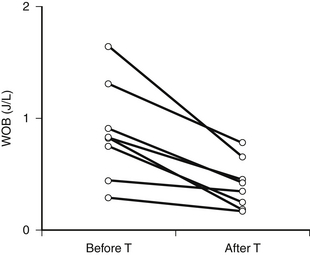Chapter 25
Care of the Challenge-to-Wean Patient 
Prevalence
Predicting survival in PMV patients is difficult. In PMV patients in long-term acute care hospitals (LTACHs), Carson and co-workers found that the combination of older age and poor prehospitalization functional status conferred a higher risk of death at 1 year. Other studies revealed a higher incidence of poor functional status and quality of life scores in PMV patients.
Predictors of Weaning Success
Traditional predictors of weaning are shown in Box 25.1. These parameters predict weaning success in patients ventilated < 7 days, but not in the PMV population. The reason for this discrepancy in predicting outcomes remains unclear. However, it probably relates to the acute-on-chronic respiratory failure affecting most PMV patients with a variety of diverse problems that affect pulmonary, respiratory muscle, and chest wall mechanics.
The presence of “good” weaning parameters (traditional or integrated) provides objective support to proceed with weaning, but it does not guarantee a successful outcome or lessen the need for attention to the nonrespiratory factors required to discontinue mechanical ventilation (see Box 25.1). Likewise, “poor” weaning indices should engender caution about progressing and call attention to factors that might compromise the weaning process. However, they should not preclude carefully monitored attempts to begin gradually withdrawing mechanical ventilation.
Factors Associated with Prolonged Mechanical Ventilation
Weakness and deconditioning are widely prevalent in ICU patients requiring mechanical ventilation. Even in healthy persons, a short duration of bed rest adversely effects skeletal muscle performance, with decreased skeletal muscle force by 15% and 20% at days 14 and 35, respectively. Calf and thigh muscle volumes decreased, with a decrease in both slow- and fast-twitch muscle fiber size. Prolonged mechanical ventilation and immobility can weaken the diaphragm, just as occurs in other skeletal muscles. In an animal model, mechanical ventilation for 11 days caused a 25% decrease in maximum transdiaphragmatic pressure and endurance. Correspondingly, diaphragm-biopsy specimens obtained from human subjects on continuous mechanical ventilation for 18 to 69 hours showed atrophy of both slow- and fast-twitch muscle fibers. Diaphragmatic and accessory respiratory muscle weakness contributes to an overall decrease in functional status and impairs weaning from mechanical ventilation.
Neuromuscular weakness is also commonly found in the ICU. Critical illness via associated inflammatory mediators frequently results in critical illness myopathy as well as critical illness neuropathy (Chapter 48). These conditions may be exacerbated by the use of glucocorticoids and neuromuscular blocking agents (Chapter 6). These complications can prolong weaning duration and hospitalization in ICU patients. Although generally reversible, critical illness myopathy and neuropathy require intense and often prolonged rehabilitation.
Factors That Increase Work of Breathing (WOB)
WOB may be increased by processes that raise airway resistance, decrease lung compliance, or stimulate respiratory drive beyond the normal range of minute ventilation (Box 25.2). Lumens of endotracheal tubes acquire an invisible biofilm over several weeks of use that markedly increases the tube’s airway resistance. Nonetheless, although the timing is debated, placing a tracheostomy tube facilitates weaning by decreasing resistive and elastic loads and thereby the ![]() WOB (see Figure 25.E1). This decreased WOB facilitates slow, progressive weans in deconditioned patients with lung mechanics impaired by a chronic underlying disease (e.g., chronic obstructive pulmonary disease [COPD]). Other benefits of tracheostomy include easier suctioning, improved patient comfort and mobility, and the potential for earlier initiation of speaking and oral feeding.
WOB (see Figure 25.E1). This decreased WOB facilitates slow, progressive weans in deconditioned patients with lung mechanics impaired by a chronic underlying disease (e.g., chronic obstructive pulmonary disease [COPD]). Other benefits of tracheostomy include easier suctioning, improved patient comfort and mobility, and the potential for earlier initiation of speaking and oral feeding.
Rehabilitation in Patients Receiving PMV
Patients with chronic respiratory failure suffer from deconditioning, related to prolonged bed rest and the catabolic nature of their disease. The ability to sit, stand, and ambulate improves functional status and psychological outlook, prevents the complications of immobility, and facilitates weaning (Chapter 21).
< div class='tao-gold-member'>
Stay updated, free articles. Join our Telegram channel

Full access? Get Clinical Tree




